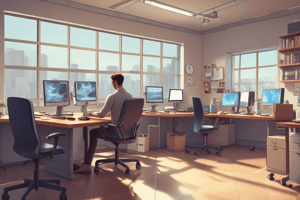Podcast
Questions and Answers
What is a core principle in Workplace Design according to the text?
What is a core principle in Workplace Design according to the text?
- Neglecting user comfort and safety in design decisions
- Providing an environment that precludes any physical strain and harm (correct)
- Encouraging clutter and disorganization in the workspace
- Maximizing employee stress levels
What should a workspace primarily facilitate?
What should a workspace primarily facilitate?
- Creating physical strain for employees
- Encouraging an uncomfortable work environment
- User comfort and safety (correct)
- Hindering the tasks that workers perform
What does Workplace Design aim to maximize according to the text?
What does Workplace Design aim to maximize according to the text?
- Physical strain and harm
- Space efficiency (correct)
- Workspace clutter
- Stress levels among employees
How does an aesthetically pleasing workspace contribute to the work atmosphere?
How does an aesthetically pleasing workspace contribute to the work atmosphere?
In Workplace Design, what is essential for supporting current work processes and future changes?
In Workplace Design, what is essential for supporting current work processes and future changes?
What is a key aspect of Workplace Design mentioned in the text as part of 'Ambience'?
What is a key aspect of Workplace Design mentioned in the text as part of 'Ambience'?
What is the main goal of workplace ergonomics in workplace design?
What is the main goal of workplace ergonomics in workplace design?
How does understanding ergonomic principles help in workplace design?
How does understanding ergonomic principles help in workplace design?
Why is it important to customize the work environment according to worker's needs?
Why is it important to customize the work environment according to worker's needs?
What does task variation aim to prevent in the workplace?
What does task variation aim to prevent in the workplace?
How does workplace ergonomics contribute to reducing the risk of injury?
How does workplace ergonomics contribute to reducing the risk of injury?
What is the ultimate goal of ergonomic strategies in workplace design?
What is the ultimate goal of ergonomic strategies in workplace design?
How can a well-designed workspace contribute to improving productivity?
How can a well-designed workspace contribute to improving productivity?
What is the primary goal of implementing effective workplace design and ergonomics?
What is the primary goal of implementing effective workplace design and ergonomics?
How does promoting employee well-being relate to workplace design?
How does promoting employee well-being relate to workplace design?
What does workplace design refer to?
What does workplace design refer to?
Why is it essential to specifically define workplace design for a particular situation?
Why is it essential to specifically define workplace design for a particular situation?
How does implementing ergonomic design help in reducing workplace injuries?
How does implementing ergonomic design help in reducing workplace injuries?
Study Notes
Core Principles of Workplace Design
- Facilitation of collaboration and productivity as a primary focus of workspace design.
- Aims to maximize efficiency and adaptability to support various tasks and workflows.
Aesthetic Impact on Work Atmosphere
- An aesthetically pleasing workspace enhances mood and motivation, creating a positive work environment.
- Contributes to a sense of well-being, ultimately improving overall job satisfaction and performance.
Importance of Supporting Processes
- Flexibility is crucial to accommodate current workflows and future changes in operations or technology.
- Ensures that the workspace can evolve to meet the dynamic needs of the organization.
Ambience in Workplace Design
- Key aspects of ambience include lighting, color schemes, and spatial layout that influence employee comfort and focus.
- A favorable ambience can enhance creativity and engagement among employees.
Goals of Workplace Ergonomics
- Main goal is to design workspaces that optimize human capabilities while minimizing discomfort and risk of injury.
- Understanding ergonomic principles enables customization of work environments, leading to better health and productivity.
Customization of Work Environment
- Essential to tailor workspaces to individual worker needs to foster comfort and improve efficiency.
- Addresses the diverse requirements of employees, promoting inclusivity and productivity.
Task Variation and Injury Prevention
- Aims to prevent monotony and repetitive strain by incorporating varied tasks and movements into daily routines.
- Helps maintain worker engagement and reduces physical limitations caused by repetitive activities.
Contribution to Injury Risk Reduction
- Ergonomics leads to the design of furniture and equipment that reduce strain on the body, subsequently lowering the risk of injury.
- Well-implemented ergonomic strategies create safer work environments, promoting employee health.
Ultimate Goal of Ergonomic Strategies
- To achieve a harmonious balance between productivity, comfort, and safety in the workplace.
- Focuses on enhancing the overall experience for employees, leading to long-term benefits for organizations.
Productivity Improvement Through Design
- A well-designed workspace fosters better focus and efficiency, leading to enhanced productivity levels.
- Strategic design elements can streamline workflows and encourage optimal performance.
Goals of Effective Workplace Design and Ergonomics
- To create environments that support employee well-being and efficiency in fulfilling their roles.
- Enhancements in workplace design lead to overall organizational success through improved workforce satisfaction.
Relationship Between Well-being and Design
- Promoting employee well-being is an integral part of workplace design, as it affects morale, retention, and productivity.
- Well-designed spaces contribute to mental and physical health, fostering a positive organizational culture.
Definition of Workplace Design
- Workplace design encompasses the planning and organization of physical spaces to optimize working conditions.
- A focus on functionality, aesthetics, and ergonomics ensures that spaces meet the needs of employees effectively.
Importance of Specific Definitions
- Defining workplace design for particular situations allows for targeted solutions that address unique organizational challenges.
- Ensures that the design effectively meets the needs of the workforce and operational goals.
Ergonomic Design for Reducing Workplace Injuries
- Implementing ergonomic design principles helps to create more comfortable and safe workspaces.
- Reduces physical strain and enhances employee safety, leading to fewer workplace injuries.
Studying That Suits You
Use AI to generate personalized quizzes and flashcards to suit your learning preferences.
Description
Test your knowledge on core principles in workplace design fundamentals, covering aspects like physical layout, furniture selection, ambience, technology incorporation, and space efficiency.




